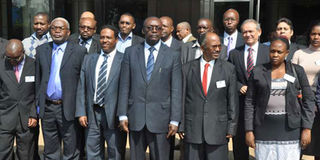Africa has been trying to open up airspace

The steering committee for Common Market for Eastern and Southern Africa (Comesa) airspace integration project. PHOTO | DANIEL NTWARI | NATION MEDIA GROUP
What you need to know:
"We are hoping to get approval from heads of state. Ministers of Uganda, Kenya, Rwanda and South Sudan will approve the deal in a meeting set before the end of Sept,” Mr Joe Nyagah, the head of the Northern Corridor Integration Projects Summit in Kenya
Countries in Africa have tried before to open up their skies with little success.
All approaches to this goal have been based on the Yamoussoukro Declaration.
The declaration Air Transport Policy was adopted in 1999 and endorsed in 2000 as a decision of the Assembly of the African Union (AU).
The policy calls for the liberalisation of African skies for the continent’s airlines, and aims at establishing a single African air transport market and avoid restrictions imposed by bilateral air service agreements.
It is yet to be fully implemented.
AFRICAN AIR MARKET
“We hereby express our commitment to the immediate implementation of the Yamoussoukro Decision towards the establishment of a single African air transport market and open our air transport market to each other,” said an African Union statement released at the AU meeting in Addis Ababa, Ethiopia, on January 2015.
At the meeting, Egypt, Ethiopia, Kenya, Nigeria, South Africa, Zimbabwe, Rwanda, Benin, Cape Verde, Congo Republic, Cote d’Ivoire embraced liberalisation of airspace, leaving out 43 other countries who are members of the AU.
The AU has insisted that the continent needs to have a liberalised airspace to ease movement of passengers and goods and reduce costs.
There are ongoing awareness efforts to encourage AU member governments to grant unrestricted access for African airlines.
CHALLENGES
Challenges such as how to monitor and use the airspace, civil and military use of the airspace and fear of competition from established airlines have been the sticking points.
The East African Community (EAC) member countries also came up with a framework on a one area airspace that has faced similar barriers in implementation.
A tripartite effort by the Common Market for Eastern and Southern Africa (Comesa), EAC and Southern African Development Community (SADC) also aims to convince member countries to agree to a liberalised airspace.
SADC which incorporates 15 South African countries has an independent framework to establish a liberalised air space among member countries.
AFRAA, the African Airline Association based in Nairobi, has for many years been at the forefront to lobby African governments to lessen tax burdens, reduce fees, improve aviation infrastructure, enhance training facilities and implement fully the Yamoussoukro Declaration.
YAMOUSSOUKRO DECISION
More than 10 AU member states are now committed to implement the Yamoussoukro Decision towards the establishment of a single African Air Transport market by 2017.
Under the AU, member states will be constituted as a working group at ministerial level in order to achieve its goal and it will remain open to those that will join later.
Notably absent from Eastern Africa in the AU agreement are Tanzania, Uganda and Burundi. There is however a chance for member countries to join as the discussions are ongoing.
Because of the tribulations of KQ, Kenya has every reason to expedite the liberalisation agreement among its partners along the Northern Corridor Integration Projects Summit.
Already, together with Uganda, Rwanda and South Sudan, Kenya is handling major projects to expedite the growth of the region.





